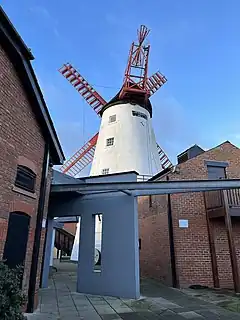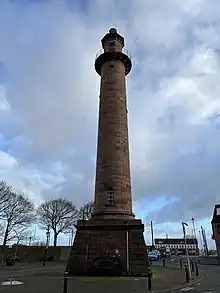| Marsh Mill | |||||||||
|---|---|---|---|---|---|---|---|---|---|
 The mill in 2023 | |||||||||
| Origin | |||||||||
| Mill location | Thornton, Lancashire | ||||||||
| Grid reference | SD 335 426 | ||||||||
| Coordinates | 53°52′30″N 3°00′43″W / 53.8749°N 3.0120°W | ||||||||
| Year built | 1794 | ||||||||
| Information | |||||||||
| Purpose | Corn mill | ||||||||
| Type | Tower mill | ||||||||
| Storeys | Five | ||||||||
| No. of sails | Four | ||||||||
| Type of sails | Patent sails | ||||||||
| Windshaft | Cast iron | ||||||||
| Winding | Fantail | ||||||||
| Fantail blades | Eight | ||||||||
| No. of pairs of millstones | Four | ||||||||
| |||||||||
Marsh Mill is an 18th-century tower windmill in Thornton, Lancashire, England. It was built in 1794 by Ralph Slater for local landowner Bold Hesketh. It functioned as a corn mill until the 1920s and has been fully restored. It is a good example of a complete English windmill and has been designated a Grade II* listed building.[1]
History
Marsh Mill was commissioned by local landowner Bold Hesketh of Rossall Hall and built in 1794 by Fylde millwright Ralph Slater.[2][3] Marsh Mill was named after the marshy area in the north Fylde that was drained by Hesketh for the mill's construction.[4] Slater was a well-known millwright in the area; he also built mills at Pilling and Clifton.[5] The mill was initially used to grind different grades of flour.[6] From the early 19th century, it was used to grind meal for farm animal feed.[4][6] In the 19th century, the original chain and wheel winding gear was replaced with a four bladed fantail.[1][6] The original common sails were replaced with patent sails in 1896.[1] The mill stopped working in the 1920s.[7] From 1928 to 1935 Marsh Mill functioned as a café.[4] In 1930, two women who intended to buy the mill fell and died while inspecting it when the fantail staging collapsed when they stood on it.[4]
It was designated a Grade II* listed building on 24 March 1950.[1] The Grade II* designation—the second highest of the three grades—is for "particularly important buildings of more than special interest".[8] Beginning in 1965, a 20-year restoration took place by the Marsh Mill Preservation Society.[5] Further restoration was completed in 1990, bringing the machinery to full working order.[1][4] It has been described as the "best preserved" and "finest" windmill in the north-west of England.[5][6][9] English Heritage have called it "an exceptionally complete example of a tower windmill in a national context".[1]
Structure
Marsh Mill is built of rendered brick; it is more than 70 feet (21 m) tall and has five storeys.[6][10] The tower tapers and it has plain square windows.[5] There is a two-storey kiln house attached.[1] The ground floor and first floor are storage areas and have drying rooms.[6] The second floor is the meal floor.[1] It contains corn-dressing machinery.[6] At the second floor, there is an external wooden stage that encircles the tower and is supported by stone corbels at the first floor level.[1] This staging gives access to the sails.[6]
The third floor is the stone floor, which contains four sets of millstones.[1] The top floor is the dust floor.[6] Like many Fylde windmills, the tower is topped with a boat-shaped wooden cap.[1][6] It now has a "Lees Flyer" fantail.[5]
See also
References
- Footnotes
- 1 2 3 4 5 6 7 8 9 10 11 Historic England, "Marsh Mill (1073150)", National Heritage List for England, retrieved 17 June 2011
- ↑ Rennison, pp. 216–17
- ↑ Fields, pp. 150–51
- 1 2 3 4 5 "Marsh Mill — A Brief History — Introduction", wyrebc.gov.uk, Wyre Borough Council, archived from the original on 22 July 2011, retrieved 17 June 2011
- 1 2 3 4 5 Hartwell & Pevsner, pp. 667–68
- 1 2 3 4 5 6 7 8 9 10 Bilsborough, p. 48
- ↑ Ashmore, p. 225
- ↑ "Listed Buildings", National Heritage List for England, English Heritage, archived from the original on 26 January 2013, retrieved 13 June 2011
- ↑ Brown, p. 118
- ↑ "Marsh Mill — Introduction", wyrebc.gov.uk, Wyre Borough Council, archived from the original on 22 July 2011, retrieved 17 June 2011
- Sources
- Ashmore, Owen (1982), The Industrial Archaeology of North-west England, Manchester University Press ND, ISBN 0-7190-0820-4
- Bilsborough, Norman (1989), The Treasures of Lancashire, North West Civic Trust, ISBN 0-901347-41-8
- Brown, R. J. (1976), Windmills of England, Hale, ISBN 0-7091-5641-3
- Fields, Kenneth (1998), Lancashire Magic & Mystery: Secrets of the Red Rose County, Sigma, ISBN 1-85058-606-3
- Hartwell, Clare; Pevsner, Nikolaus (2009) [1969]. Lancashire: North. New Haven and London: Yale University Press. ISBN 0-300-12667-0.
- Rennison, Robert William (1996), Civil Engineering Heritage: Northern England, Thomas Telford, ISBN 0-7277-2518-1
External links
 Media related to Marsh Mill at Wikimedia Commons
Media related to Marsh Mill at Wikimedia Commons


